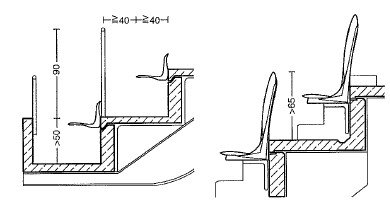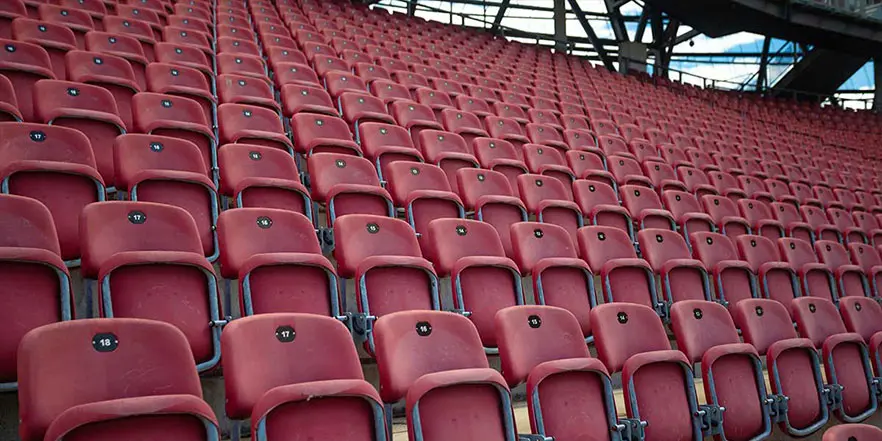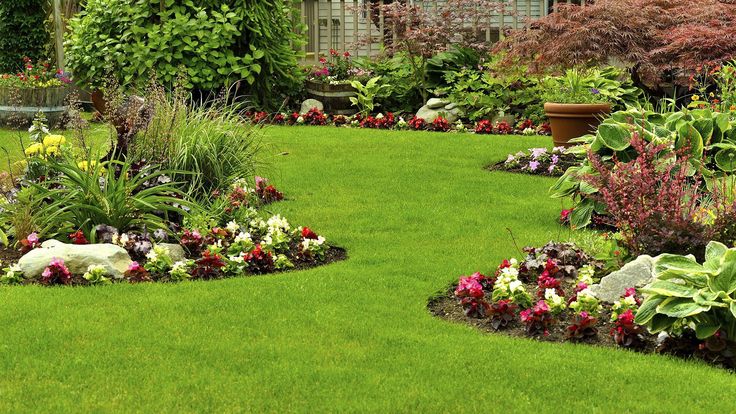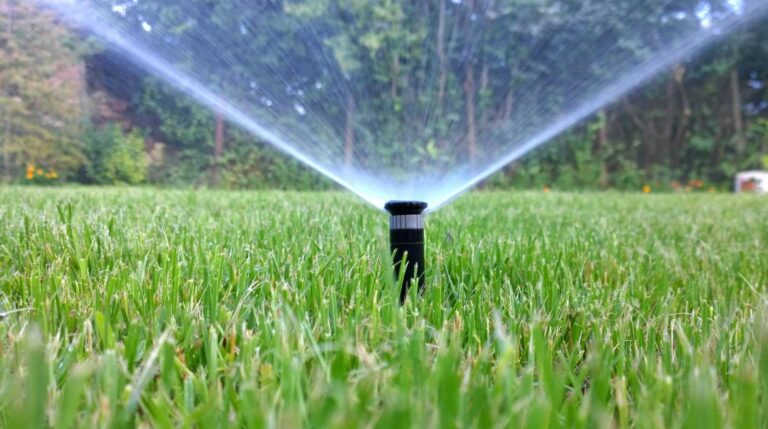The latest stadium seating designs: Innovation and comfort
When you think about the fan experience at any major sporting event, the Benches, bleachers, sports fields They play a pivotal role in determining the level of comfort and enjoyment. No longer just a place to sit, seating has become part of the overall spectator experience, from smart design that maximizes comfort, to the integration of technology that enhances the interaction with the sporting event. As the industry rapidly evolves, stadiums are competing to offer state-of-the-art designs that go beyond comfort to provide an immersive and enjoyable experience that leaves a lasting impression.
Sports stadium seating designs: Toward an innovative and personalized viewing experience
Designs have become sports stadium seating and bleachers In recent years, engineers and designers have sought to improve the fan experience by offering seats that are comfortable, durable, and functional. These modern designs take into account long-lasting comfort, durability, and optimal ventilation to ensure fans have an exceptional viewing experience. Here are the key features that characterize modern stadium seating designs:
Innovative designs to maximize comfort and longevity
At sporting events that can last for long hours, comfortable seating is essential for fans to maintain a high level of comfort throughout the entire seating experience. Modern seating designs are based on geometric shapes that fully support the body, while distributing weight evenly to minimize pressure on specific points of the body.
These designs are characterized by comfortable back supports and the ability to adjust the seating angle to suit different body shapes and sizes. Some stadiums incorporate movable mechanisms to adjust the space between seats, giving fans more personal freedom and comfort.
Using modern materials to improve durability and comfort
One of the most notable shifts in the design of sports stadium seating is the use of innovative new materials that combine durability and comfort. Modern seats are often made of highly durable composite materials such as polyurethane and polycarbonate, which are characterized by their high resistance to abrasion and fluctuating weather conditions. These materials ensure a long lifespan, even with constant exposure to various weather factors such as extreme heat or rain.
At the same time, the comfort properties of these materials are enhanced by padded and flexible designs, with the use of comfortable synthetic fabrics and leathers that prevent slippage and maximize the seating experience. These materials are resistant to environmental factors and retain their attractive appearance for a long time without the need for costly maintenance.
Consider ventilation and proper weight distribution
One of the key aspects developed in modern seat designs is ventilation and weight distribution. The new seats rely on advanced technology that allows natural ventilation of the body through vents integrated into the seat design or the use of breathable materials. This minimizes sweating and increases seating comfort in hot weather, as these vents allow air to flow and cool the body.
In addition, weight is optimally distributed through innovative seat designs, minimizing strain on muscles and joints, especially at longer events. The seats are also designed to withstand different weights without loss of comfort, making them suitable for fans of different weights and sizes.
Customized sports field bleacher seats to enhance comfort
are considered sports stadium bleacher seats Customizable seating is one of the most prominent innovations in modern stadium design, reflecting the growing need to meet the needs of diverse audiences. These seats offer sophisticated customization options, making it easier to enhance the experience for fans of all types, from sports fans to those with special needs. Here are some of the key features of customizable bleacher seating:
Customization options by sport type and audience size
Customizable seating is a versatile option for different types of sports and audience sizes. Stadiums that host various sporting events, such as soccer, basketball, or even concerts, need specific seating designs to ensure fan comfort. For example, larger seating dimensions can be designed for events that require large crowds, allowing for increased capacity without compromising comfort.
Moreover, stadiums can choose specific designs according to the type of sport. In basketball stadiums, seats can be closer to the court for a more intimate viewing experience, while soccer stadiums may need different designs that ensure a clear view of the field from different angles.
Possibility of customization based on the needs of people with special needs
Customizable bleacher seats also take into account the needs of those with special needs, offering options to modify the seats to meet the needs of these individuals. These options include customized accessible seating, with enough room for wheelchairs.
In addition, seats can be designed to include features such as a height adjustment mechanism, allowing the disabled to get the best possible view, and some stadiums offer specialized seating with additional facilities, such as adjustable armrests or nearby storage spaces.
Colors and designs that match the identity of the stadium or team
Colors and designs are an integral part of a stadium or team’s identity, so a wide range of colors and designs are available for Benches Stadium bleachers Customizable. Stadiums can choose colors that match the team’s identity or designs that reflect the culture of the region where the stadium is located.
Seats can be designed with unique details that reflect the team’s logo or use custom colors in line with the stadium’s identity, fostering a sense of belonging among fans. This type of customization not only helps improve the aesthetics of the stadium, but also enhances the fan experience and encourages fans to attend more often.
Safety standards adopted in modern seat design
are considered to be Stadium seating Modern seating is pivotal in enhancing the spectator experience, with an increasing focus on comfort and safety. The design of these seats requires strict standards to ensure the safety of the audience and meet their physical needs. Here are the key aspects related to comfort and safety in modern seating.

Modern seating designs follow approved safety standards that ensure spectators are not exposed to any risks. These standards include the use of strong and fire-resistant materials, which minimizes the risk of fire in the event of an emergency. Seats are also required to be designed to prevent slippage and provide adequate support, ensuring they are stable even in the event of sudden movement.
In addition, seating height and seating angles are considered to minimize the chances of accidents. These standards create a safe environment for spectators and minimize the risk of injuries, whether caused by the design of the seats or by unforeseen accidents.
How to optimize seating design to reduce physical strain on viewers
Comfort in sports seats requires innovative designs that minimize the physical strain that spectators may experience during long periods of sitting. To achieve this, several factors are emphasized such as:
- The seats are designed to provide full back and thigh support, minimizing pressure on the spine and increasing seating comfort.
- High-quality materials are used to design ergonomic cushions that conform to the curves of the body. These cushions enhance the seating experience, optimizing long-term comfort.
- The seats are designed to distribute weight evenly, minimizing pressure on certain areas of the body and preventing fatigue or discomfort.
The role that sports stadium seating plays in providing better safety spaces in emergencies
Modern stadium seating plays a vital role in providing adequate safety spaces in case of emergencies. Empty spaces between seats and exit routes are essential to ensure that spectators can evacuate quickly and safely in an emergency. Seat design is used to ensure that evacuation routes are clear and easily accessible.
In addition, the flexible seating design enables it to reconfigure spaces when needed, such as during major events or crises. This design can be used to create space to facilitate the movement of people, ensuring that everyone can access emergency exits quickly and efficiently.
Types of stadium seating designs
There are many designs of Stadium seating to meet different needs, ranging from fan comfort to safety requirements. Here are some of the main types of seating designs used in sports stadiums:
- Fixed seats
Fixed seats are the most common in stadiums, as they are permanently installed. These seats offer a high level of comfort and often have armrests and ample space, making them suitable for large sporting events. Their design can be simple or sophisticated depending on the level of the stadium, and can include customization options for colors and logos.
- Folding Seats
Folding seats are commonly used in multi-purpose stadiums, allowing the capacity to be enlarged or reduced as needed. These seats are designed to be lightweight and easy to store, making them an ideal choice for events that require capacity flexibility. Folding seats can come with additional support for greater comfort.
- 3. Seats in sports stadiums for people with special needs
Accessible seating is an essential element of modern stadium design. These seats are designed to provide easy access and comfort for people with disabilities, and are often strategically placed in the stadium to ensure good visibility. These seats include options such as ample space for vehicles, special supports, and customizations based on individual needs.
- Hanging seats
Suspended seating is a recent innovation used in some stadiums, where they are suspended from support structures rather than placed on the ground. These designs provide a sense of comfort and openness, allowing spectators a clear view of the stadium. Suspended seating is typically used in modern stadiums that seek to provide a unique fan experience.
- Smart Seats
Smart seats are part of recent trends in seating design, incorporating technology to provide a personalized experience. These seats may have electric chargers, displays, and integrated entertainment systems. These designs enhance the fan experience by providing live information and interactive games.
- Comfortable and luxurious seats
Comfortable and luxurious seats are aimed at higher income groups, offering a high level of comfort and additional services. These seats incorporate high-quality materials, such as leather or premium fabric, and come with options such as food and beverage delivery directly to the seats. These seats are usually located in premium areas of the stadium, ensuring a luxurious experience for fans.
Requires designs Stadium seating for sports stadiums Consider many factors, from comfort and safety, to technological requirements and customization. With innovations on the rise, modern stadiums can offer distinctive experiences that cater to the needs of all fans, enhancing the overall sporting event experience.
Characteristics of sports stadium seating
are considered sports stadium bleacher seats are essential elements that greatly affect the fan experience. There are many features to consider when designing these seats, to ensure the comfort and safety of the users. Here are some of the key features:
- Comfort
Comfort is one of the most important characteristics of stadium seating. Seats should have a design that conforms to the shape of the body, with good back and armrest support, helping fans to sit for long periods of time without feeling tired. Comfortable materials such as fabric or leather can be added to improve comfort.
- Ventilation
Good ventilation in seats provides a comfortable experience for fans, especially at long sporting events or during hot weather. Designing seats with vents or using breathable materials can help reduce temperature and increase comfort.
- Durability
Durability is an essential characteristic that seats must have, as they must withstand intensive use and weathering. Materials such as high-quality plastics, stainless steel, or treated wood contribute to durability and ensure a long lifespan.
- Safety
Stadium seating must comply with international safety standards to ensure the safety of fans. This includes designing seats to minimize the risk of slipping or falling, as well as using non-flammable materials. The seats must also be easily accessible in case of emergency.
- Ease of maintenance
Ease of maintenance is an important feature, as benches should be easy to clean and maintain to ensure they look good over time. Using stain- and corrosion-resistant materials can minimize the need for frequent maintenance.
- Personalization
Stadium seating allows for customization to meet different needs. Seats can be customized by sport or team visual identity, enhancing the fan experience and adding a unique touch to the venue.
- Proper weight distribution
Proper weight distribution is an important characteristic of seat design. Properly designed seats distribute weight evenly, minimizing pressure on sensitive areas of the body and increasing comfort.
- Modern technologies
Some seats utilize modern technologies such as smart seats, which include electric charging or interactive screens. These technologies provide a unique experience for fans, enhancing their engagement with sporting events.
In conclusion …
are considered to be Stadium seating Customizable seating is a pivotal element in enhancing the fan experience at sporting events. By catering to all groups, including those with special needs, these seats foster a sense of belonging and comfort. The ability to customize seating according to the type of sport and audience size, as well as providing colors and designs that match the stadium’s identity, goes a long way in creating a fun and engaging environment for fans. Investing in Benches, bleachers, sports fields Customizable is a strategic step for stadiums towards achieving an unforgettable sports experience that reflects professionalism and attention to detail.



